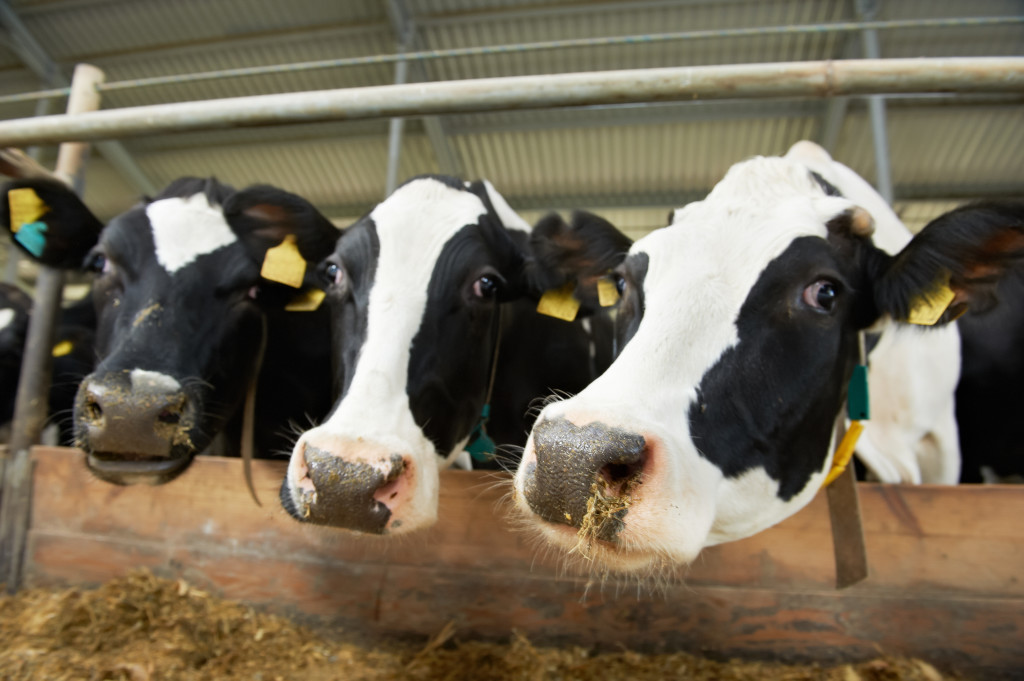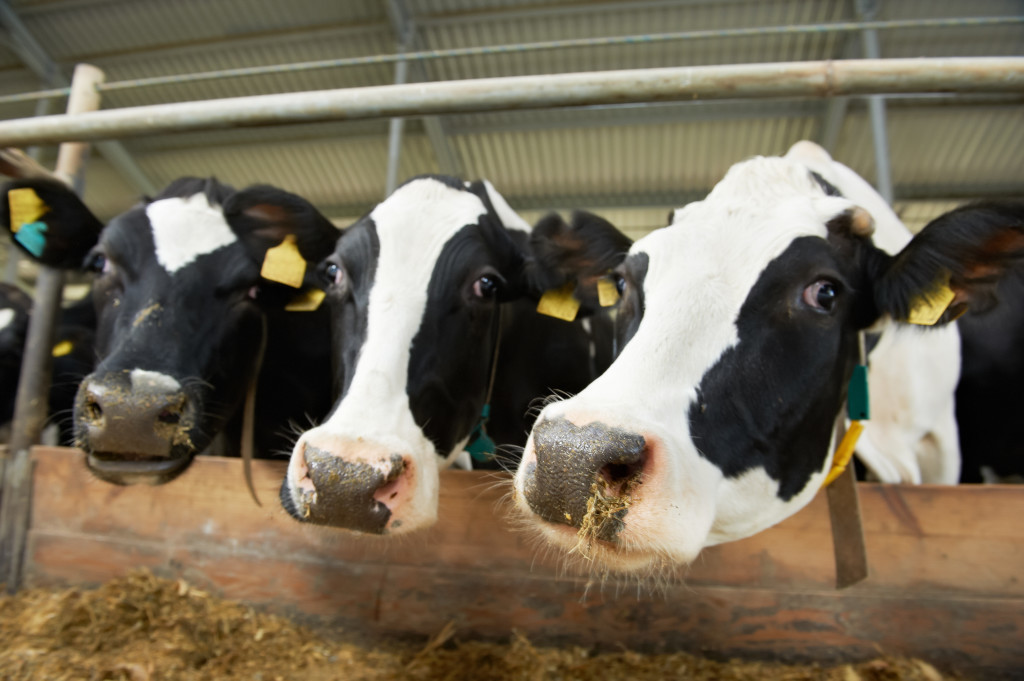
Curious milch cows at barn stall in farm
Whether you drink milk, eat cheese and butter, or consume dairy in bread, coffee or cereal, you are feeding your body something that is basically unhealthy, harmful to the environment, and cruel to animals. As you will learn here, dairy products do not contain any nutrients that you cannot obtain from other sources, so there is absolutely no reason to continue consuming it.
Extreme Cruelty to Dairy Cows
Cows provide milk for a period of ten months after they have given birth. The cows on dairy farms are repeatedly artificially inseminated to keep them almost permanently pregnant and permanently lactating. Many cows are given hormones which make them produce large numbers of embryos that are then implanted into other cows.
Dairy cows are either genetically manipulated or given hormones to make them produce about twelve times as much milk as they would otherwise have done, usually about 80 litres per day. In fact, where a normal cow has only two litres of milk stored up at any given time, dairy cows must live with 20 stored litres.
They are tied to milking machines for hours a day, during which they stand on hard concrete. The rest of the time they are either left to stand on that concrete, or caged in over-crowded enclosures from which they can be moved to the milking machines with ease. The constant milking often causes their mammary glands to become inflamed, which makes milking absolutely excruciating.
Even though cows usually have a lifespan of between 20 and 25 years, dairy cows are killed by the time they are five because by then their permanent pregnancy and terrible living conditions have ruined their bodies to the extent that their meat cannot even be used for anything other than animal food. In fact, many simply collapse because of lameness and can no longer stand up to be milked.
Unlike the people who drink their milk, Britain’s 1.8 million dairy cows can never play with friends, develop their personalities, raise their babies, or even roam around freely.
Extreme Cruelty to Newborn Calves
About half a million unwanted calves are born from dairy cows in the country every year. These newborns are not permitted to remain with their mothers for more than a day. In fact, since their mothers’ milk is meant to be sold to humans, the calves are often given animal blood to drink for the first few months of their lives.
The lives of female calves often look very much like those of their mothers. Those who escape that fate are raised on a fattening milk substitute for months to make them put on a lot of weight. They are then slaughtered to provide the tender young meat that is in such high demand with meat eaters.
Male calves are fed on the same fattening milk substitute to fatten them up quickly, caged indoors to keep their meat tender, and deprived of iron to produce the pale-coloured meat that veal lovers crave.
Due to the unnatural indoor living, the unhealthy diet, and the constraints on moving around, these calves are always anaemic, suffer from diarrhoea and digestive problems, and are terrified. Their mothers cannot protect them or care for them. They suffer and then they are slaughtered.
If you still have the stomach for it, you can learn more from PETA UK, Animal Aid, and Viva.
Dairy Does not Protect Against Bone Fractures and Osteoporosis
If you consume dairy because you believe the calcium is required to develop and maintain your bones, you can stop. Dairy is not a good source of calcium and many studies show that either its acid content or the animal protein it contains may actually be responsible for bone loss. One study of 77,761 women aged between 34 and 59 showed that those who consumed the most dairy foods broke more bones than those who did not. Another study showed that consumption of dairy products, particularly at a young age, was associated with an increased risk of hip fracture in old age. Those who consume dairy seem to have weaker bones, probably because, when the body struggles to neutralise the acid contained in milk, it borrows calcium from the bones to help.
Those studies that fail to find a relationship between dairy consumption and osteoporosis and/or fractures basically conclude that dairy has no bone benefits at all, including for children.
Calcium is certainly required for the maintenance of your bones, together with the vitamin D that promotes its absorption by your body. But soybeans, quinoa, kale, spinach, and other green vegetables are far superior sources of calcium without the risks. Some studies, in fact, show that you can get the same bone protection from soy milk that medical experts used to believe you could get from milk. Milk does not contain vitamin D at all, without which your body cannot absorb calcium.
Dairy May be Linked to Premature Aging
Together with all the good nutrients it contains, milk is also a source of D-galactose. Studies on animals and people suggest that chronic intake of D-galactose has so many poor effects on health that it may actually hasten death. This should perhaps not be surprising, when considering that milk is meant to be consumed by calves specifically to help them age and develop quickly.
Dairy May be Linked to Heart Disease
Dairy products contain saturated fat and lactose, both of which have been associated with heart disease. Lactose has been found to increase the risk of ischemic heart disease and butter seems to increase the risk of heart attack.
At this stage the research is not unanimous. Dairy products differ from each other with regard to the risk they pose, and researchers are still struggling to design a study that properly separates them and measures their risk factors accurately.. However, with safe sources of the same nutrients being available in some many plants, it seems unnecessary to take the chance.
Dairy May be Linked to Cancer
Some studies have found a relationship between dairy intake and especially Prostate, breast, and ovarian cancers. The mechanism whereby it increases the risk for these cancers is not yet understood, but it may be related to the increased oxitive stress suffered by the cells of people who consume it, or to the insulin-like growth factor (IGF-1) that dairy products contain.
75% of Humans are Lactose Intolerant
Most people do not know whether they are lactose intolerant or not, because they have been consuming dairy products throughout their lives. They thus believe that their bodies can process dairy, simply because they have not experienced how much better they feel without dairy. Lactose intolerance causes digestive problems like bloating, constipation, and a lack of energy. The high level of lactose intolerance in humans is predictable, since their bodies stop producing enough lactase, the enzyme required for processing lactose, by age five.
Dairy Causes allergies
Dairy products promote the formation of mucous. Ask any singer what the worst food type is for mucous that they must absolutely avoid before singing; they will tell you it is dairy. As a result, dairy can cause or contribute to any existing mucous-related condition, including hay fever, blocked sinuses, and respiratory disorders. If you suffer from seasonable allergies, cut dairy from your diet to see whether the symptoms improve.
Dairy Products May Cause Type 1 Diabetes
Some studies show an increase in type 1 diabetes as a result of dairy consumption, especially in children. While it might not be as bad as type 2 diabetes, sufferers do struggle with increased thirst, increased urination, abdominal pain, and fatigue.
Dairy Products Contain Many Contaminants
Dairy products contain many contaminants. Cattle feed contains pesticides that have been linked to a wide range of diseases. Cows are genetically altered and injected with hormones to make them produce more milk. Antibiotics are used to treat cows’ mastitis, which may ultimately cause antibiotic resistance in milk drinkers.
Free Range Dairy
Opting for free range dairy is not the answer. Free range milk is also produced by cows that are repeatedly artificially inseminated. Their calves are removed even earlier to prevent any bonding from taking place. The calves are sold to be treated similarly to the calves of factory farmed cows, unless they are lucky and they are shot immediately after being removed from their mothers. Animal Aid, a British organisation, has reported some cases where cows managed to break out of enclosures and walked miles across fields to look for their calves.
The only difference is that free range cows are permitted to roam in larger outdoor enclosures. They may, as a result, live longer than factory farmed cows. In their case, this means little more than increasing the number of babies taken away from them and increasing the number of milking sessions they must endure. They still live as little more than cash cows.
Environmental Destruction
The cattle industry is said to be responsible for around 20 per cent of the planet’s greenhouse emissions. Since 20 per cent of Britain’s farm cattle are dairy cows, the contribution of the dairy industry could be approximately four per cent of the damage. Most of this is methane, which is arguably the most harmful gas because it traps more heat in the atmosphere than even carbon dioxide.
Around five per cent of the entire planet’s water is used by the dairy industry to clean their equipment, flush cow manure, grow cow feed, and to give to the cows to drink. Moreover, water in soil and rivers is polluted by pesticides from cow feed and from 55 kilograms of manure per cow per day. As such, the dairy industry harms biodiversity, because pesticides and the ammonia in the manure kill fish and other animals that depend on the water.
Conclusion
Dairy products are unhealthy. Their production is environmentally destructive and cruel to the cows and calves that are trapped in the industry. In addition, it is easy to replace them with plant products in ones diet. There is, therefore, no reason to continue consuming them. Consult a good vegan recipe books and websites for some dairy alternatives. You will feel healthier and more virtuous when you do.
